STUFFED
Grow Your Own Stuffing
Thanksgiving is a time of year when one’s thoughts naturally turn to . . . stuffing. No, not stuffing yourself, but stuffing a turkey. Even many people who choose not to eat turkey on Thanksgiving nonetheless do enjoy stuffing themselves with stuffing.
So why not think about what ingredients for stuffing can be reaped from the garden? Even better, how about setting aside a little portion of the garden next year as a stuffing garden?
The bread and butter of any stuffing is some starchy food, often bread and butter itself, the bread usually as crumbs. There’s no breadcrumb plant, so forget about growing breadcrumbs. Not that you couldn’t buy some wheat “berries” at a health food store, plant them next spring, harvest the grain when the plants dry down, thresh and winnow out the berries, grind them into flour, make the flour into bread, then let the bread go stale and pound it into bread crumbs.

Growing breadcrumbs– I did it once!
Whew! Most of us are not going to do this.
Then again, if some grain was going to be the starchy base of your stuffing, you could get Ritzy and use wild rice, which costs more than bread crumbs but may be easier to get home grown into stuffing. That is, easier if you happen to have a permanently wet spot — six inches of slowly running water is ideal — in which to grow this grain, and you plant the seed sometime between now and early spring.
Five Short Years, Maybe Less
Five years will have to elapse before stuffing can be made if its main ingredient is your home grown chestnuts. Then again, chestnut stuffing can be delicious, and does seem most authentic because wild turkeys anyway once stuffed themselves with once-abundant wild chestnuts.
So why not plant a chestnut tree and patiently wait? 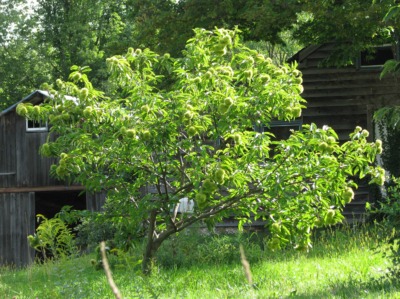 As they say in China, “The longest journey begins with the first step.” And speaking of China, Chinese chestnuts are resistant to the blight that decimated our native American chestnuts, as are some hybrid chestnuts such as Nanking, Crane, Qing, and Peach. You’ll need two different varieties for cross-pollination.
As they say in China, “The longest journey begins with the first step.” And speaking of China, Chinese chestnuts are resistant to the blight that decimated our native American chestnuts, as are some hybrid chestnuts such as Nanking, Crane, Qing, and Peach. You’ll need two different varieties for cross-pollination.
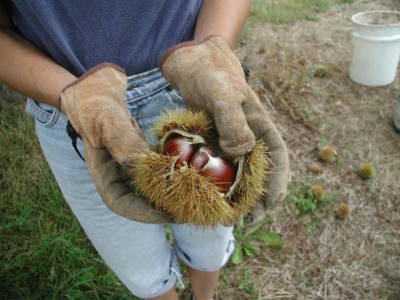
Colossal chestnut
Dry and Mealy
While you are waiting to harvest chestnuts, make stuffing based on one of the more quickly grown starchy vegetables. Potatoes, for instance. The best potatoes for making stuffing will be those that are dry and mealy, varieties such as Nooksack and Butte.
“Dry and mealy” is also the mantra to use when choosing a winter squash variety to grow as a base for stuffing. “Squash stuffing” has a nice ring to it, doesn’t it? As does “stuffing squash,” which is how you’re going to prepare your stuffing. My recommendation for a dry, mealy squash is a buttercup type called Chestnut or Sweet Mama.
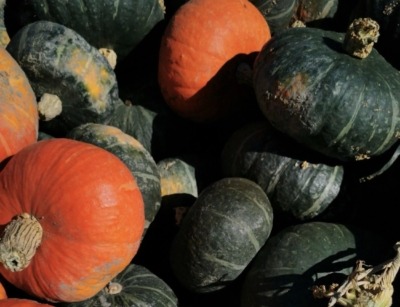
Buttercup squashes
A most authentic stuffing should be based on nu nu, a golfball-sized, starchy tuber also called makoosit or groundnut. Native Americans harvested and ate nu nu, and this was one of the foods crucial in helping the Pilgrims survive their first winters in Massachusetts.
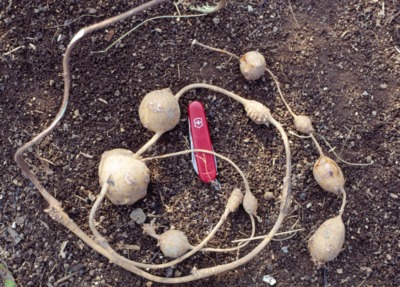
Nu nu tubers
Be careful planting nu nu because it can spread like a weed to give you more stuff for stuffing than you would ever need. That said, the plants do sport decorative and sweetly fragrant, lilac colored flowers.
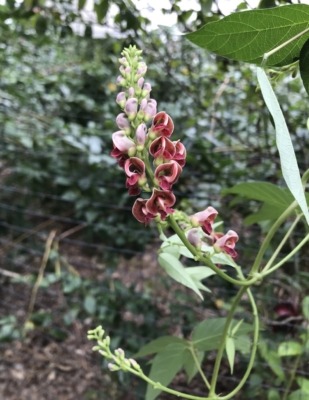
Nu nu flowers
And the Garden is Complete
Let’s move on to some seasonings for your stuffing. Parsley, sage, rosemary, and thyme come to mind, as do summer savory and sweet marjoram. Sage and thyme are perennials, each also available in designer flavors: pineapple sage and caraway thyme, for example. Rosemary is a perennial, too, but only where it survives winters outdoors, which it won’t do here. Rosemary is happy enough to spend its life in a pot. I keep it indoors in winter, trained as a small tree, to provide pretty greenery, piney fragrance, and savory snippings for the kitchen.
Finally, round out the flavors and bulk with some pickings from the vegetable garden. Onion, garlic, celery, and carrots will be mainstays, but vegetables such as parsnips and garlic can make special — and powerful — flavor contributions.
Now we need a design for this dedicated stuffing garden. The chestnut tree casts shade, so will have to be off by itself. Enclosure might be provided by mounds of hilled potatoes or squash vines trained along a low, rustic fence.
Within, why not a knot garden? A knot garden is a tapestry of colors and textures defined by various plants. The makings of stuffing provide a more than adequate palette, from the spiky leaves of onions to the gray green leaves of sage to the dainty, dark green leaves of thyme.
For a centerpiece, make a rustic arbor up which can twine nu nu stems. But do keep the nu nu from spreading or the whole garden will become a nu nu garden.
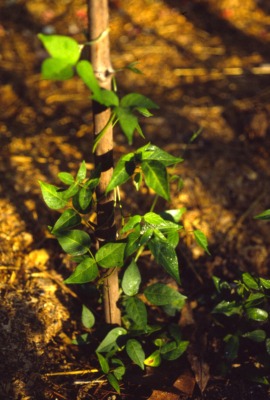
Nu nu vine climbing pole



Leave a Reply
Want to join the discussion?Feel free to contribute!